| |
|
|
||
| |
|
|
||
| |
| Bosnian Traditions Bosansko Sijeloî: A Bosnian Coffee Party |
Cultural Roots
Music and dance are part and parcel of Bosnian social life. As in many Eastern bloc and European countries, folk music and dance are taught to children in school; young adults are encouraged to study folk dance and music at university.
Folk festivals and
competitions between performing arts groups were a major part of Bosnian life, and amateur groups called Cultural Art Societies were common throughout the republic.
Required to perform the dance, music, andsong of Bosnia, Croatian, and Serbia, they
were often not permitted to specialize in the traditions of only one group. In Iowa there are two folk dance groups, Sevdah in Des Moines and Text by Riki Saltzman. Photos by Will Thomson, Bill Lockwood, & Riki Saltzman.
|
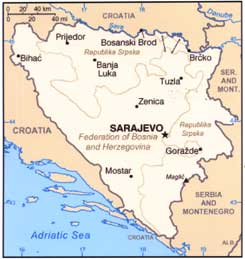
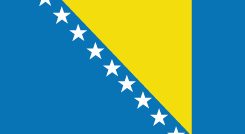
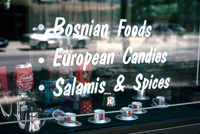 Today Iowa is a new home for more than twelve thousand Bosnians. Between 6,000 and
7,000 are settled in Des Moines and Ankeny. Approximately 4,500 live in the Cedar
Valley Area, in and around Waterloo. Smaller Bosnian communities exist in Iowa City and
Davenport, where folks gather mostly around sport and cultural clubs. It is hard to find a
large company in Des Moines or Waterloo that doesn't have an employee who speaks
Bosnian. Bosnian books can already be seen on bookshelves in libraries, schools, and
bookstores. Bosnian music, dances, and food are well known. And there are Bosnian
stores, restaurants, and coffee bars in both Des Moines and Waterloo. Although it is
impossible to totally recreate one's traditions in a new country, people make adjustments
and substitutions and eventually change from Bosnians to Bosnian Americans.
Today Iowa is a new home for more than twelve thousand Bosnians. Between 6,000 and
7,000 are settled in Des Moines and Ankeny. Approximately 4,500 live in the Cedar
Valley Area, in and around Waterloo. Smaller Bosnian communities exist in Iowa City and
Davenport, where folks gather mostly around sport and cultural clubs. It is hard to find a
large company in Des Moines or Waterloo that doesn't have an employee who speaks
Bosnian. Bosnian books can already be seen on bookshelves in libraries, schools, and
bookstores. Bosnian music, dances, and food are well known. And there are Bosnian
stores, restaurants, and coffee bars in both Des Moines and Waterloo. Although it is
impossible to totally recreate one's traditions in a new country, people make adjustments
and substitutions and eventually change from Bosnians to Bosnian Americans. 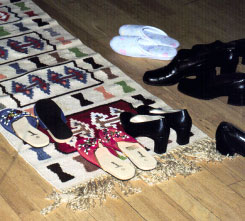
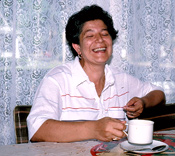
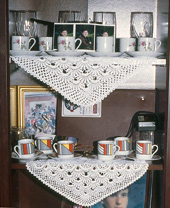 One cannot enter a Bosnian house without being offered coffee, which like British tea,
means a small meal and not just coffee! Elaborate homemade pastries, talk, singing, and
women's handcrafts are all a part of the more elaborate and very social women's get-
together. Bosnian coffee itself, which is made like Turkish coffee (grounds are boiled and
allowed to settle) and served with lump sugar and slightly sweet candies, is strong, thick,
and served in small cups like espresso. Coffee parties provide a time to sit down, rest, and
catch up on local events and family matters.
One cannot enter a Bosnian house without being offered coffee, which like British tea,
means a small meal and not just coffee! Elaborate homemade pastries, talk, singing, and
women's handcrafts are all a part of the more elaborate and very social women's get-
together. Bosnian coffee itself, which is made like Turkish coffee (grounds are boiled and
allowed to settle) and served with lump sugar and slightly sweet candies, is strong, thick,
and served in small cups like espresso. Coffee parties provide a time to sit down, rest, and
catch up on local events and family matters. 
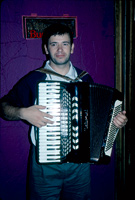
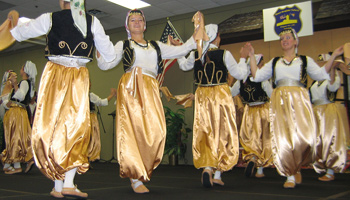
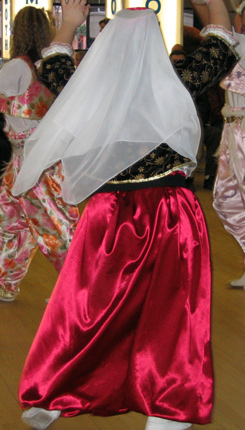 K.U.D. Kolo in
Waterloo. The adult leaders of both of these groups encourage their students to study the
language, song, music, and culture of their former homeland as well as the traditional
dance. Bosnian musicians in Iowa can be heard in bars and at social events. The bands play social
dance music, and young and old join in traditional line dances that weave their way around
the dance floor. There is usually a minimal barrier between audience and band, so patrons enthusiastically join in with the singing of popular and traditional songs.
K.U.D. Kolo in
Waterloo. The adult leaders of both of these groups encourage their students to study the
language, song, music, and culture of their former homeland as well as the traditional
dance. Bosnian musicians in Iowa can be heard in bars and at social events. The bands play social
dance music, and young and old join in traditional line dances that weave their way around
the dance floor. There is usually a minimal barrier between audience and band, so patrons enthusiastically join in with the singing of popular and traditional songs. 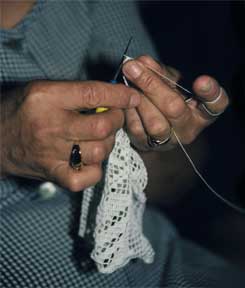
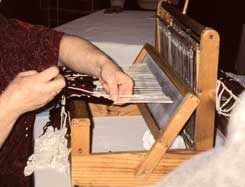 Slightly less common as a
handcraft is knitting, which is generally used to create socks and mittens in geometric
patterns that resemble those of Scandinavia and Germany. Cilim (rug) weaving is
definitely becoming an endangered art. As refugees, very few Bosnians were able to take
precious family cilim with them when they fled their homeland. Since the end of the war,
travel back and forth has been possible again, however, and traditional cilim, tightly woven
of fine wool, can more frequently be seen in Bosnian American homes.
Slightly less common as a
handcraft is knitting, which is generally used to create socks and mittens in geometric
patterns that resemble those of Scandinavia and Germany. Cilim (rug) weaving is
definitely becoming an endangered art. As refugees, very few Bosnians were able to take
precious family cilim with them when they fled their homeland. Since the end of the war,
travel back and forth has been possible again, however, and traditional cilim, tightly woven
of fine wool, can more frequently be seen in Bosnian American homes.